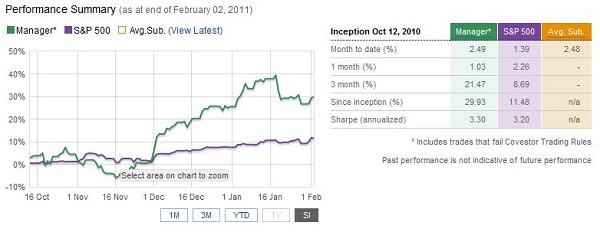 Author: Gerald Gehman
Author: Gerald Gehman
Covestor model: Undervalued Growth Companies
Disclosure: Long EZCH
Overview
EZchip Semiconductor (Nasdaq: EZCH) is a fabless semiconductor company that provides Ethernet network processing units (NPUs) for use in telecom networks, data centers and enterprise backbones. Ethernet technology increases bandwidth, lowers costs and creates uniform technology in existing network systems. NPUs are used in Ethernet switches and routers to process the exponential growth in internet traffic.
Five of the six largest Tier-1 carrier networking equipment vendors – Marvell for Cisco, Juniper, ZTE, Huawei, and Ericsson – are existing purchasers of EZchip’s high speed processors. EZchip’s newly developed low speed processors are now offered to 14 vendors, of which 11 are already EZchip customers.
Internet traffic is growing too fast for existing networks. The increasing demands of triple play – data, voice and video (primarily video) – require a new system, or major improvements on the old.
EZchip NPUs use Carrier Ethernet technology to offer the cheapest and greatest improvement to existing networks. Their chips have special advantages because they process information at the speed of light and can be programmed for system upgrades from a central office.
Internet systems are expensive and time consuming to build and redesign. First sales have taken time, but now that EZchip NPUs are broadly used, the company has a significant competitive advantage. High speed processors are used in a system for 6 to 8 years and low speed processors are used 2 to 3 years.
EZchip designs merchant chips that can be used and modified in multiple systems, as opposed to Application Specific Integrated Circuits (ASICs) that are designed for a specific purpose. The company offers the widest range of processors, from 1-Gibabit to 200-Gibabits per second.
Of greater importance, EZchip constructs its NPUs to be interchangeable and programmable to facilitate cost effective system upgrades.
The company has sold processors to a broad base of customers that historically use them for two to eight years. Demand for the established chips should increase revenues, in multiples, for years to come.
EZchip is also testing new NPUs that the company believes are two to three years ahead of their competition. These new products should help EZchip continue to penetrate existing markets.
Financials (all data from Yahoo Finance)
EZchip (founded in 1989 as LanOptics, Inc) is located in Yokneam, Israel and is incorporated under the laws of Israel. Financial statements are prepared in USD.
Revenues were $8.5MM in 2006, $40MM in 2009 and 44.9MM for 9 Mo, 2010.
Since Q1-2006, every quarter, except Q2-2009 had sequentially higher revenue.
Non-GAAP income was -$6.7MM in 2006, +$14MM in 2009 and 21.8MM for the first nine months of 2010 (the company reports results for Q4 2010 on February 10, 2011).
Cash and Equivalents were $20,627 in 2005 and $93.1MM on 9/30/10.
EZchip has no significant debt obligations.
In 2009, EZchip’s NASDAQ stock price ranged between $10 and $18. In 2010, the price ranged between $12 and $29. On 1/21/11, the stock closed at $29.92. The market cap at that time was $760.6M.
I believe EZchip is positioned to post significantly higher sales and earnings figures. I believe the stock, now trading at 17.6 times earnings, will trade at 25 to 28 times projected earnings, and I have a 12 month target on the stock of $45-50 per share.
Strategy
The growth strategy of EZchip is to develop chips that are (1) interchangeable, (2) programmable and (3) years ahead of their competition. Already EZchip has developed new NPUs (NP-4 and NP-5) that provide more functions on a single chip than are available from currently available chips.
Cisco’s major decision to employ EZchip NPUs could allow them to jump years ahead of Juniper in product development. EZchip is positioned to participate in all Carrier Ethernet segments.
Competition
The chip market has been highly competitive, with new protocols and technologies creating a difficult environment.
EZchip states that internally developed chips (ASICs) are its main competition now. Other competition comes from Sandburst Corporation, Bay Microsystems, Xelerated Inc, Agere Systems and Wintegra Inc that offer various products in different parts of the market.
To achieve success, EZchip has been forced to educate their customers to the advantage of their merchant chips:
(a) Speed to incorporate EZchip in final product
(b) Interchangeable NPUs that can be easily upgraded
(c) Programmable chips whose software can be modified for new technology
(d) Cost
The education process has been long and challenging. Professionals in separate divisions must still be convinced and trained.
Significant progress has been made. Now that NPUs have been incorporated into the market, the NPUs cannot be replaced without re-designing the CESR. Once installed, repeat orders are highly probable because the life cycle of the equipment is 6 to 8 years.
Juniper indicates they intend to market their own “trio chipset” in 2011. It now appears this could be significantly delayed. New chips require customers to design new software and also require a long qualification process.
Production
EZchip outsources all production to Taiwan Semiconductor Manufacturing Co. (TSMC) and IBM.
Cisco wanted to use EZchip NPUs in the “core” of their new products, but did not feel comfortable buying directly from a small Israeli company. EZchip licensed the larger company, Marvell, to take responsibility for having a special NP-3c manufactured by TSMC and delivered to Cisco.
It appears that the Marvell arrangement is working very well. Cisco benefits from Marvell’s technical expertise in developing chips and also its manufacturing leverage on TSMC. EZchip will continue to work with Marvell on their NP-3 and other chips.
Risks
Customer concentration will always be a significant risk for EZchip. Just six major companies control the CESR market, with Cisco controlling over 50% and Juniper over 14%. Four other companies share most of the remaining 36%.
Juniper has contributed significantly to revenues, but they will most likely be replaced with Marvell (for Cisco who controls 50% of the CESR market). The timing for the decline of Juniper and the rise of Cisco appears favorable, but is not guaranteed.
Business in the access market is more evenly divided between fourteen vendors. However, the product cycle in the access market is much shorter – 2 to 3 years. Even if EZchip is successful in penetrating the access market, they must always be competitive in price and technology.
Growth in the entire Carrier Ethernet market could slow down due to economic conditions. This would hurt revenues and earnings of EZchip.
EZchip processors are on the cutting edge of technology. Obsolescence is always a concern. They must successfully invest in R & D to maintain a lead on competitive products and emerging technologies.




